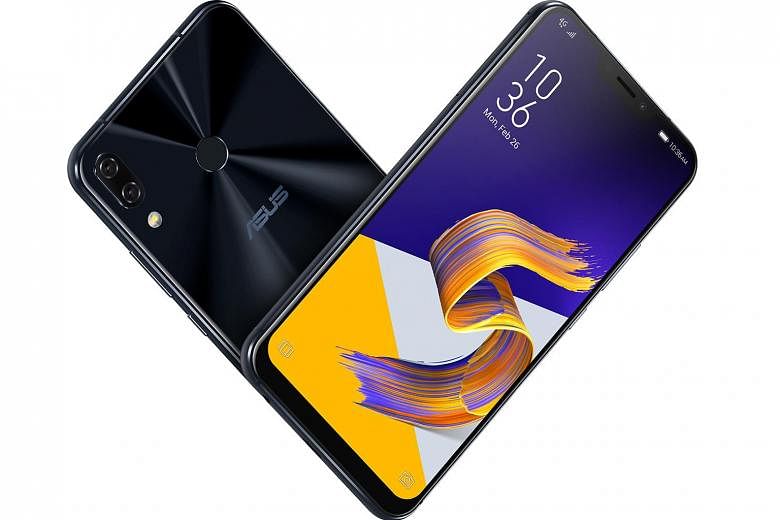The Asus ZenFone 5 is the latest Android smartphone to sport an iPhone X-like notch at the top of its screen. The iPhone's influence extends to the ZenFone's dual rear cameras, which are aligned in a similar portrait orientation.
The problem with copying the iPhone is that most Android apps are not able to handle a notched design.
Netflix videos and games run like they would on a standard screen with a black bar covering the notch and its sides. They do not use the extra screen real estate enabled by the notch. Of the apps I try, YouTube is the only one that expands to fill the entire screen.
On the plus side, the ZenFone has an excellent 6.2-inch LCD screen. It has a 19:9 aspect ratio with Full HD+ resolution. It looks bright and punchy, with Asus claiming support for the wide-gamut DCI-P3 colour space. However, it does not support high-dynamic-range videos like some flagship phones.
In addition, the ZenFone has features that are not found on the iPhone X, such as a rear fingerprint sensor and 3.5mm audio jack.
More importantly, it offers a good user experience and runs smoothly for a mid-range $488 smartphone that is less than one-third the price of an iPhone X.
-
SPECS
PRICE: $488
PROCESSOR: Qualcomm Snapdragon 636 (Quad-core 1.6GHz, quad-core 1.8GHz)
DISPLAY: 6.2-inch, IPS LCD, 2,246 x 1,080 pixels, 402 ppi pixel density
OPERATING SYSTEM: ZenUI 5 (Android 8.0)
MEMORY: 64GB, 4GB RAM
REAR CAMERA: 12MP (f/1.8), 8MP wide-angle (f/2.0)
FRONT CAMERA: 8MP (f/2.0)
BATTERY: Non-removable 3,300mAh
-
RATING
FEATURES: 4/5
DESIGN: 4/5
PERFORMANCE: 4/5
VALUE FOR MONEY: 4/5
BATTERY LIFE: 3/5
OVERALL: 4/5
Compared with previous Asus smartphones, the increased responsiveness of the ZenFone 5 is probably due to the reduced bloatware on its Android-based Zen UI software. It uses Google apps for e-mail, messaging and keyboard input instead of Asus-branded apps.
The only pre-loaded third-party apps are Facebook and Instagram, which can be disabled, but not removed.
The new Qualcomm Snapdragon 636 processor in the phone is said to be 40 per cent faster than its predecessor. In the Geekbench 4 benchmark, it scored 1,324, compared with about 800 for older mid-range chips.
If that is not impressive enough, the ZenFone can perform better by enabling AI Boost, a feature that increased the score to 1,515. However, Asus warns that the feature reduces battery life.
Asus plays fast and loose with the use of "artificial intelligence" (AI).
Going through the ZenFone's marketing spiel, there are plenty of AI-powered features, such as keeping the screen turned on when a user is looking at it, or tuning the volume of the ring tone to be audible by considering the noise level of the surrounding.
The ZenFone also detects that I have started the Geekbench app and offers to enable the AI Boost feature. But while these are smart and useful features, they do not involve machine-learning, which is how AI is defined.
That is not to say the ZenFone is devoid of true AI features. For instance, the camera software can detect scenes (up to 16 types), such as food, flowers and sunsets, and adjust the camera settings for the best photo. This is similar to the Huawei P20 Pro, which boasts 19 types of scene detection.
Its dual-camera system, consisting of a 12-megapixel main camera and a wide-angle secondary camera, is competent and captures plenty of detail in well-lit surroundings. Portrait mode, with the camera blurring the background of a subject, is supported, though the overall effect is a bit more dramatic than I like.
Its low-light performance is decent, but not as good as more expensive models. There is more noise, while light sources such as lamps become a blurry bright mess.
Battery life is average for a smartphone - the ZenFone clocked 9.5 hours in The Straits Times' video-loop battery test.
You will probably need to charge it at the end of the day.
• Verdict: With the competitively priced ZenFone 5, Asus has upped its smartphone game, especially with its software. Both the display and the dual-camera system are good for a mid-range device.


